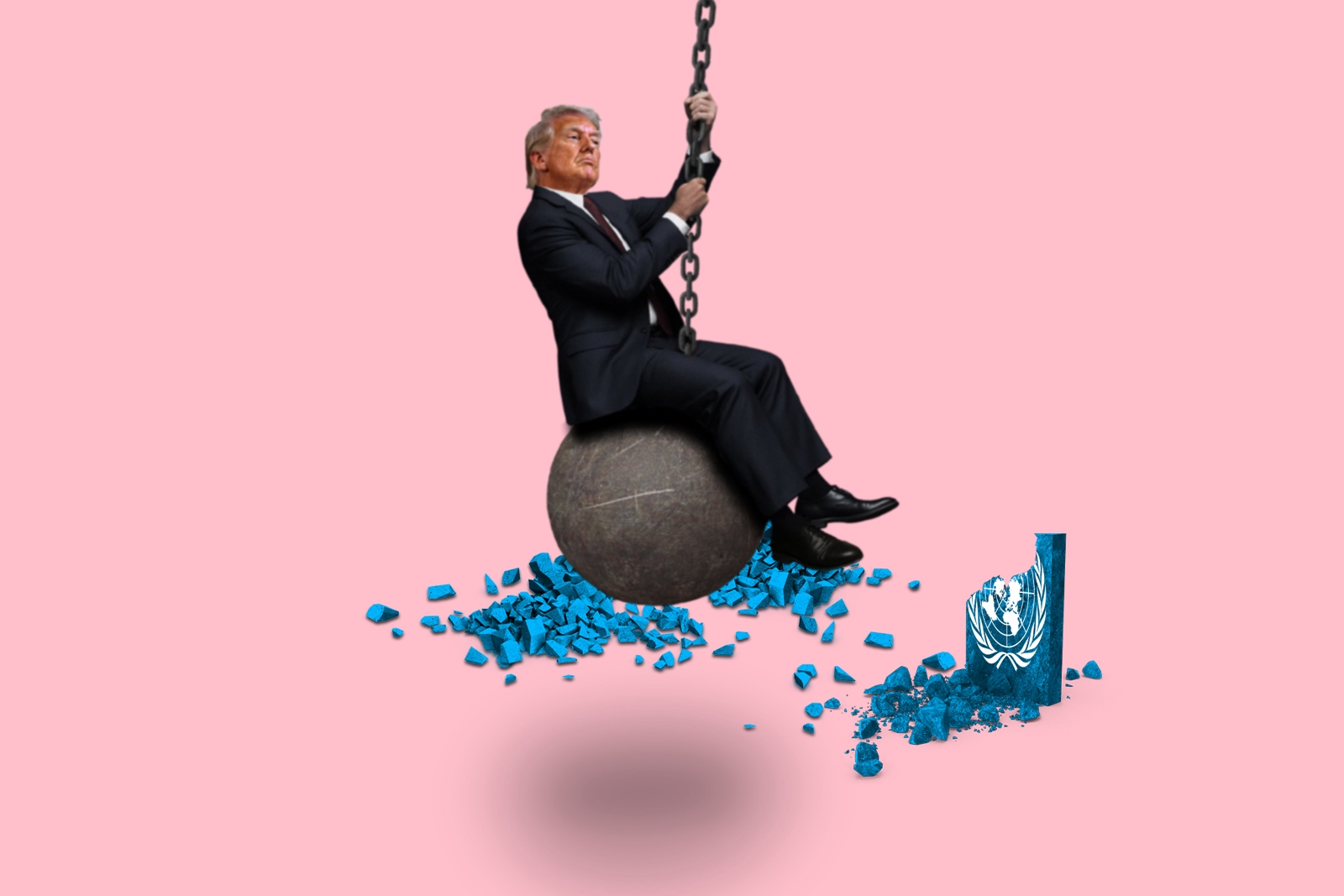
The Wrecking Ball Doctrine: Trump’s Transactional Vision of Global Order
The mid-20th century was an age of American architecture. Out of the ruins of global war, Washington drew up a blueprint for political and economic life and appointed itself general contractor. The United Nations institutionalized sovereignty. Bretton Woods stabilized currencies. The IMF and World Bank mobilized capital. NATO yoked allies into a military covenant. None of this was charity. These were instruments of power, binding partners to American primacy while draping hegemony in the garments of universality. Liberal internationalism was always steel beneath silk.
And yet the United States has never been entirely at ease inside the house it built. Woodrow Wilson conceived the League of Nations, only to see his Senate refuse entry. Richard Nixon tore away the Bretton Woods gold anchor when it constrained U.S. freedom of movement. George W. Bush brushed past the United Nations when it complicated his war plans. Donald Trump’s demolitionist instinct, then, is not an aberration so much as a recurring American temptation: to spurn rules of our own authorship when they cease to serve. What distinguishes Trump is not the impulse but the spectacle—the insistence that destruction itself become the point.
He treats NATO as a protection racket, the WTO as a rigged casino, tariffs as sticks rather than tools. Where earlier presidents tried to bend institutions, Trump prefers to batter them. The staging is political; the claim is philosophical. America, once Apollonian in its careful construction of order, indulges a Dionysian appetite for unmaking. In Trump, we glimpse a national paradox: an empire impatient with the scaffolding of its own power.
The wrecking ball has not spared institutions devoted to human welfare. Created in 1948 with American backing, the World Health Organization embodied the conviction that public health should stand above politics. Trump severed ties, denouncing its deference to China during the pandemic. The act revealed more than pique. It announced a shift in ethos: domains once treated as universal—health, science, and humanitarian relief—were dragged into a marketplace of leverage. Even the WHO, conceived as a symbol of shared humanity, was recast as another chip on the bargaining table.
To reduce him to a vandal alone, however, is to miss the deeper project. Trump imagines a different kind of order—not Kantian universalism, but a bazaar of sovereigns. In this marketplace, diplomacy is indistinguishable from deal-making; treaties behave like contracts; allies look like clients on retainer. The moral vocabulary of the postwar order—human rights, collective security, the rule of law—fades into background noise. What remains is an ethic of barter in which loyalty is priced and leverage itemized.
Destruction also clarifies. Were the postwar institutions truly multilateral, or were they asymmetric structures upheld by American subsidy and acquiescence? Trump’s blunt blows strip away the language of universality. They prod rivals and partners to sketch alternatives. China has been drafting a parallel architecture through the Belt and Road Initiative and the Asian Infrastructure Investment Bank, and by weaving supply-chain dependencies that function like informal treaties. Russia experiments with Eurasian counterweights. Europe tries to save fragments of liberal multilateralism while arguing over how. Across the Global South, regional bodies and South–South cooperation signal a refusal to remain props in someone else’s stage set.
What survives, despite the drama, are the pieces that still pay at home. Security guarantees remain popular where they reduce risk or cost. Market access retains a sacred aura, where it enriches exporters and investors. Sanctions endure because they gratify a punitive mood without the blood price of war. The cost of maximal flexibility, though, is minimal predictability. Contracts can be renegotiated overnight; institutions require the patience of maintenance. When foreign policy devolves into a sequence of deals, time horizons shrink, partners hedge, and the machinery of trust seizes up.
There are guardrails. Courts can stall the most brazen maneuvers. Congress can complicate withdrawals and constrain funds. Bureaucracies—despite caricature—remember the last crisis and try not to repeat it. The private sector supplies its own inertia; corporations dislike policy whiplash and lobby for continuity. But guardrails are not a direction of travel. They prevent disaster without supplying a design. Trump’s wager forces a larger question: can the United States move from negation to construction, from “No” as a governing philosophy to a plan for the day after?
The question that follows is not only what Trump dismantles, but who steps forward. Who pays the fixed costs of building if the United States declines the role of architect? Who decides whether the WHO persists as a relic or evolves into a cornerstone of a new order? History suggests that the “who” matters as much as the “what.” Great powers seldom abdicate outright; they improvise. Middle powers thrive when someone else keeps the lights on. Smaller states survive by multiplying patrons. When Washington withdraws to the cash-and-carry counter, others will design—but design to their measure.
Here, the philosophical stakes become explicit. Hobbes warned that without institutions, the world risks a state of war in which everyone is against everyone else. Nietzsche distinguished creative destruction, which clears ground for renewal, from mere vandalism, which leaves only rubble. Trump’s project teeters between the two. If the United States persists in dismantling without drafting anew, it risks passing from master builder to restless vandal—remembered not for the cathedrals of order it built, but for the ruins left behind. The irony is that even demolition depends on plans: one must know which load-bearing walls to strike. Beyond the showmanship, there must be a blueprint.
And this choice is not Trump’s alone. It belongs to the political class that indulges him, to voters who reward him, to allies who recalibrate around him, and to rivals who probe for gaps. The United States can still decide how it wants to be remembered: as the architect of institutions or as a virtuoso of demolition. The first requires patience, persuasion, and the unglamorous labor of upkeep. The second offers the addictive clarity of conflict and the quick applause that follows a swing that lands. Trump has made his preference clear. The rest of us must decide whether spectacle is enough.
A Glimpse of 2050: The Bazaar Order
Project this logic forward three decades, and the shape comes into view—familiar, yet unmistakably diminished. The United Nations persists as a shell: a podium and a calendar without enforcement. The IMF and World Bank splinter into competing regional lenders tied to China, India, and Africa. NATO dissolves into bilateral protection contracts sold like insurance policies with annual premiums. The WHO survives, but only through piecemeal funding; services are available à la carte for those who can afford them. Arbitration replaces adjudication; influence is something to be leased.
In this bazaar order, great powers stop pretending. They auction security, sell infrastructure, and barter access. Smaller states learn to navigate like merchants, triangulating among patrons and brokers; foreign ministries begin to look like procurement offices. Crises—pandemics, climate shocks, financial panics—are met less with coordination than with haggling. The decisive question is not “What do the rules say?” but “Who has cash and capacity this quarter?” Outcomes depend on liquidity, not legitimacy.
Such a system need not collapse. It may even deliver tactical wins and short-term efficiencies. But it lacks the slow solidity of cathedrals. It is a market without a temple, a corridor of stalls without a square. Humanity may discover too late that while deals can be struck in a day, institutions take generations to build—and only moments to wreck. The longer the bazaar persists, the harder it becomes to remember how the square was built in the first place.
There is a harder, less dramatic path. It begins by admitting that the postwar architecture—bruised, hypocritical, often exclusionary—nonetheless proved that states can house power inside institutions that blunt its worst uses and extend its best. Renewal would mean pruning what no longer works, widening the circle of designers, and restoring the unglamorous craft of maintenance. It would ask Americans to recover a truth our grandparents understood: that blueprints matter less than the discipline of construction.
The twenty-first century will test whether we can build when spectacle rewards only the swing of the ball. History, relentless as gravity, will ask its permanent questions: Who were the builders, and who were the wreckers? Which of them had a plan for the morning after?
